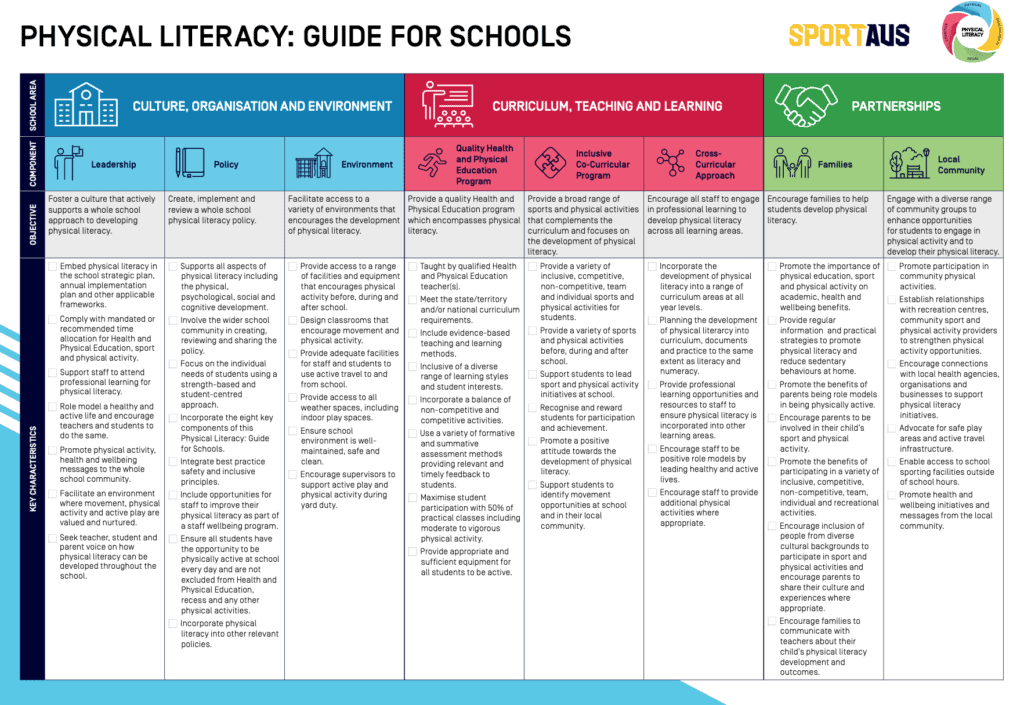
As physical literacy (PL) grows in interest so to do calls for specific guidance on how to implement a PL informed approach in schools. School leaders, educators, coaches and families all play a crucial role in promoting and developing PL in children and young adults. The development of PL can be achieved through a whole school approach, embracing daily opportunities for play, sport and physical activity.
Sport Australia has produced a comprehensive guide for schools wanting to implement more opportunities for play, sport and physical activity informed by PL. The guide is separated into four key documents, the contents of which are outlined below:
Physical Literacy Benefits for Schools
The development of physical literacy increases the physical activity levels of children, which can produce many other benefits. This document outlines clearly the benefits for school leaders, students and parents which can help provide the rationale for adopting a PL informed approach.
School Leaders

Physical literacy:
- helps develop students’ general capabilities outlined in the Australian Curriculum, including:
- critical and creative thinking
- personal and social capability
- ethical understanding
- intercultural understanding
- aligns with national health and physical education propositions
- improves student mental health and wellbeing
- addresses national and international policy and guidelines
- improves student performance on standardised tests
- improves student attendance
- helps students to explore values
- helps students become responsible local and global citizens.
Students
Physical literacy:
- improves mental health and wellbeing
- improves awareness of one’s self and capabilities
- improves self-esteem and self-confidence
- develops resilience
- improves academic performance, including improved memory and concentration
- improves social skills, including leadership, collaboration, cooperation, sharing and negotiation
- helps build friendships
- helps children learn new skills that can be applied to other aspects of student life
- develops behaviours for lifelong participation in movement and physical activity.
Parents
Physical literacy:
- improves their child’s health and wellbeing
- improves their child’s resilience
- promotes whole of child development across the physical, psychological, social and cognitive domains
- develops their child’s confidence which can be applied in other aspects of their lives
- develops their child’s relationship skills which helps with socialising
- helps develop their child’s sense of social responsibility.
The document also outlines and signposts a range of evidence to back up these claims.
Physical Literacy Guide for Schools
The physical literacy guide for schools provides a really clear one page outline of overarching guidance for schools based around the following key three areas.
- Culture, organisation and environment

- Leadership
- Policy
- Environment
- Curriculum, teaching and learning
- Quality Health and Physical Education Programme
- Cross-Curricular Approach
- Partnerships
- Families
- Local Community
Physical Literacy Implementation Plan
The implementation plan outlines a six stage approach to transitioning towards a physical literacy informed approach. The implementation plan covers the following six steps:
 1. Gain support from the school leadership
1. Gain support from the school leadership
Educating the school leadership on the benefits of a physical literacy approach is an important first step. Use the Physical Literacy: Benefits for Schools to help explain the student and school benefits of a physical literacy approach.
Ideally, you want the school leadership to:
- understand the benefits of a strong physical literacy culture
- be supportive of applying a physical literacy approach in the school
- agree to implementing the Physical Literacy: Guide for Schools.
2. Establish a working group
We recommend you establish a small working group of three to eight people, including a:
- school leader
- Health and Physical Education (HPE) teacher
- generalist teacher
- local sport or physical activity provider
- student leader
- parent
- person not specifically involved in teaching at the school, who can challenge bias and assumptions
- facilitator to guide the workshop.
3. Gather relevant materials
To help the working group understand the context and school environment in which they are working. Read and share these materials with your working group prior to running the workshop:
- Relevant school plans, policies and frameworks
- Physical Literacy: Guide for Schools
- Physical Literacy: Benefits for Schools
- Physical Literacy: Tips for Development
4. Run a workshop
Following the below process will assist you to workshop ideas, gain a shared understanding of PL and create an action plan.
- Outline and discuss the benefits of physical literacy in schools.
- Identify and discuss how children can develop literacy through a quality HPE program and through other areas of the school environment. Highlight how the whole school working together will have a much greater impact.
5. Collaborate with the whole school community
Share the PL action plan across the school community. Start with staff and student representative council. Incorporate their feedback into the action plan before broadening the consultation to include parents and citizens, and local sporting groups. Refine the action plan after each consultation.
6. Review and update the action plan
As a working group, review progress against the plan at regular intervals. Update the plan to reflect the learnings and changing school environment. This will support continuous improvement and creating a strong PL culture in your school. Suggestions include:
- Establish regular review dates and place them in staff calendars.
- Ensure review sessions include:
- Update the current status of plan
- Identify further opportunities
- Celebrate opportunities developed and ensure they are promoted to the whole school community.
Evaluate progress alongside Annual Implementation Plan and/or strategic plan reviews.
Physical Literacy Tips for Development
 This resource contains 8 additional fact sheets that expands upon the physical literacy guide for schools.
This resource contains 8 additional fact sheets that expands upon the physical literacy guide for schools.
Download the Physical Literacy For Schools Guidance Below
For more information and to read the documents in full please download a copy via the links below.



Responses